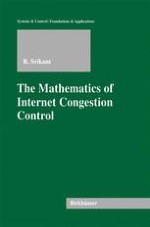2004 | OriginalPaper | Buchkapitel
Real-time Sources and Distributed Admission Control
verfasst von : R. Srikant
Erschienen in: The Mathematics of Internet Congestion Control
Verlag: Birkhäuser Boston
Enthalten in: Professional Book Archive
Aktivieren Sie unsere intelligente Suche, um passende Fachinhalte oder Patente zu finden.
Wählen Sie Textabschnitte aus um mit Künstlicher Intelligenz passenden Patente zu finden. powered by
Markieren Sie Textabschnitte, um KI-gestützt weitere passende Inhalte zu finden. powered by
In the previous chapters, we have considered only elastic users, i.e., those users that are characterized by concave utility functions. In this chapter, we will consider a specific type of inelastic users: those which require an average bandwidth (say, 1 unit) and a QoS guarantee (e.g., an upper bound on the probability of packet loss or the probability that the delay exceeds some threshold) from the network. In other words, these users would not be willing to use the network if the amount of bandwidth available is less than one unit, and further, will not use any excess bandwidth if more than one unit is provided to them. An example of such sources are voice calls, which generate packets at a rate of 8 kbps to 64 kbps, depending on the codec (coding and decoding algorithm) used, and require the delay, jitter and packet loss in the network to be small to ensure good quality of the audio at the receiver.
